How to Control Pests and Diseases in Plants
When we talk about garden pests, we think about insects that fly over the plants and lay eggs on leaves, flowers, and foliage. Contrary to popular belief, not all pests are harmful to plants. But the majority of them are.
Identifying a pest problem is the first step toward solving it. Like most problems, pest problems are easier to solve when recognized from the start.
When dealing with pests, the best approach is to follow the integrated pest management (IPM) guidelines. IPM considers interactions among people, pests, and plants to find the best way to handle it.
IPM is an ecosystem-based strategy that focuses on long-term prevention or damage to the plant. It’s essential to make sure that you’ve diagnosed the problem correctly.
How does IPM work
It was developed in 1970 in response to the overuse of pesticides. Pests are often opportunistic and result from poor plant selection or management.
You need to know what type of pest problem you are dealing with. Correct identification is vital to formulate any pest control strategy.
You should monitor the pest after you have discovered it. Keeping a diary is a great way. This allows you to know for your region and microclimate when a pest appears and starts causing damage.
A balanced approach of IPM will reduce the quantity and frequency of pesticide use, which will make your garden more self-correcting over time.
Top 20 Pests and diseases and how to control them in garden
1. Aphids

Aphids are tiny sapsuckers that reproduce quickly, causing significant damage if left unchecked. These are generally 1-5 mm long with soft bodies and long legs and antennae.
Aphids colonies often consist of winged and wingless individuals. They are weak fliers but can be carried in thermals and air currents for hundreds of miles and dispersed to new plants.
Aphids eat a large volume of soft saps. The excess sugars and water are excreted as drops of a sticky substance known as honeydew. This honeydew falls from aphids as it moves around the plant.
It attracts ants who feed on honeydew and give the aphid colonies some protection from predators and parasites.
Aphid species and plants, it attacks.
| Species | Plants affected |
|---|---|
| Rosy leaf-curling aphid | Apples |
| Mealy plum aphid | Plums and damsons |
| Cherry blackfly | Cherries, fruiting and ornamental |
| Black bean aphid | Beans and ornamental |
| Willow carrot aphid | Carrots |
| Birch Aphid | Birch |
| Root Aphid | Ornamental and glasshouse plants |
There are over 500 aphid species that are common pests of fruits, vegetables, and ornamental plants.
How to treat:
Early treatment of aphids using insecticides gives the best results. You should monitor the plant’s health and aggressively treat it for any sign of infestation. Exposed colonies of aphids can be dealt with by forcible spraying with plain water or organic and inorganic insecticide.
There are many different insecticide formulations available to gardeners for aphid control. To be effective, they must be applied before damaging populations have built up.
2. Lace Bugs
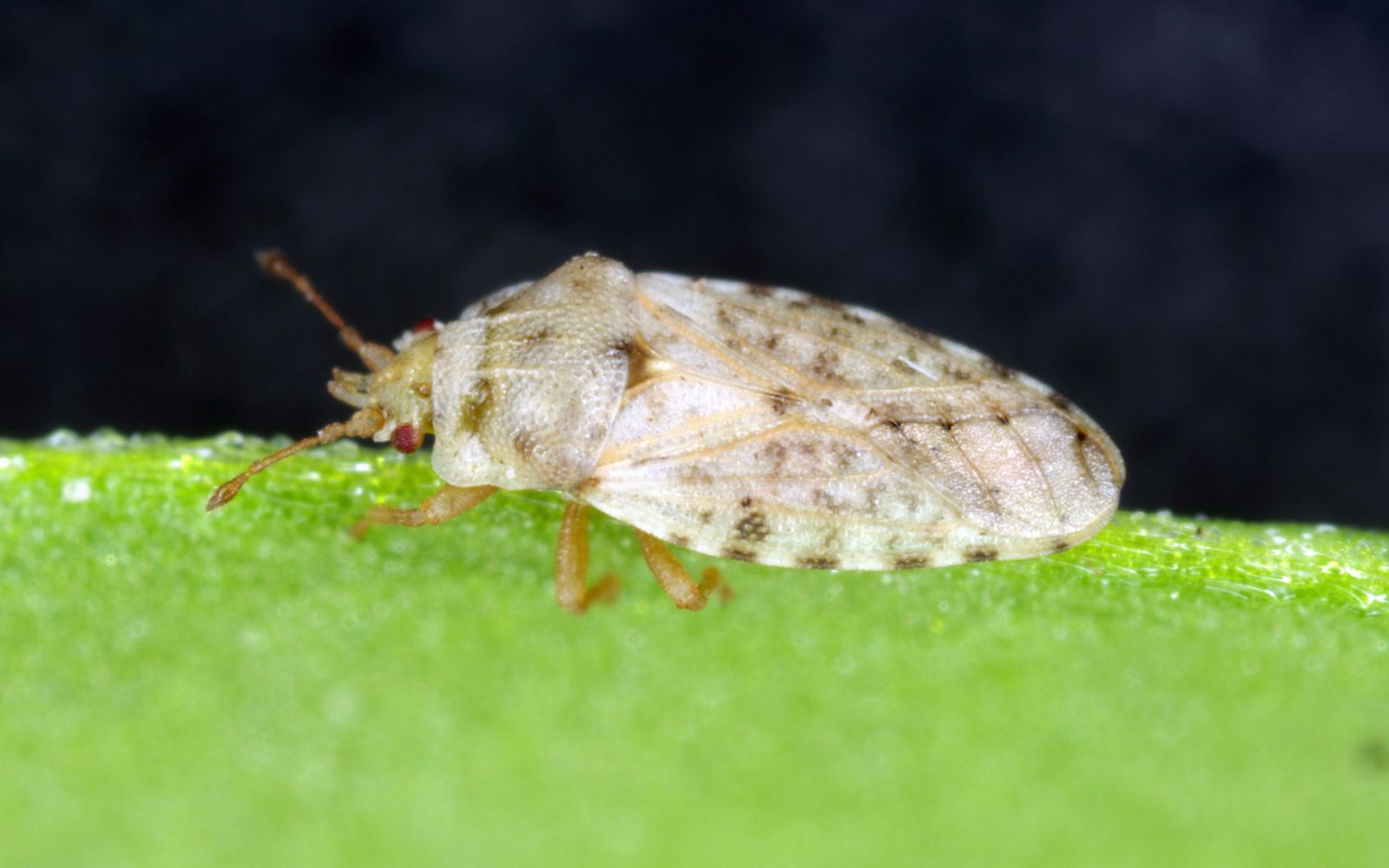
Lace bugs are small insects that are up to 6 mm long. Fully grown adults have unusual lace-like forewings and extensions from the thorax.
You can identify if the plant is infected by looking at the foliage that gets extensively discolored, yellowed and bleached.
Plants growing in the open, dry positions are more susceptible than plants growing in the shade. The Rhododendron lace bugs only attack rhododendrons, whereas the Pieris lace bug may develop on rhododendrons and pieris.
It lays eggs in autumn that hatch from May onwards. Nymphs feed on the underside of leaves in groups of 10-50. Adults mature from June onwards, and females move up onto the youngest leaves to lay eggs.
Adults have wings, but they don’t fly, and the insect colonies remain relatively static on the same plants year after year. Adults usually die during early winter, but eggs survive.
How to treat:
You should keep a close watch on plants in spring, and if you see any sign of infestation, then prune and burn affected branches in March or April.
You can spray with systemic insecticides two to three times at about three-week intervals from early May to destroy the laid eggs. Ensure to spray it thoroughly to contact colonies of bugs on the undersides of leaves.
If the infestation has just started and you find that it’s a light infestation on small plants, it can be dealt with in spring and summer. Simply shake the plant or pick off nymphs and adults by hand and kill them.
3. Whiteflies
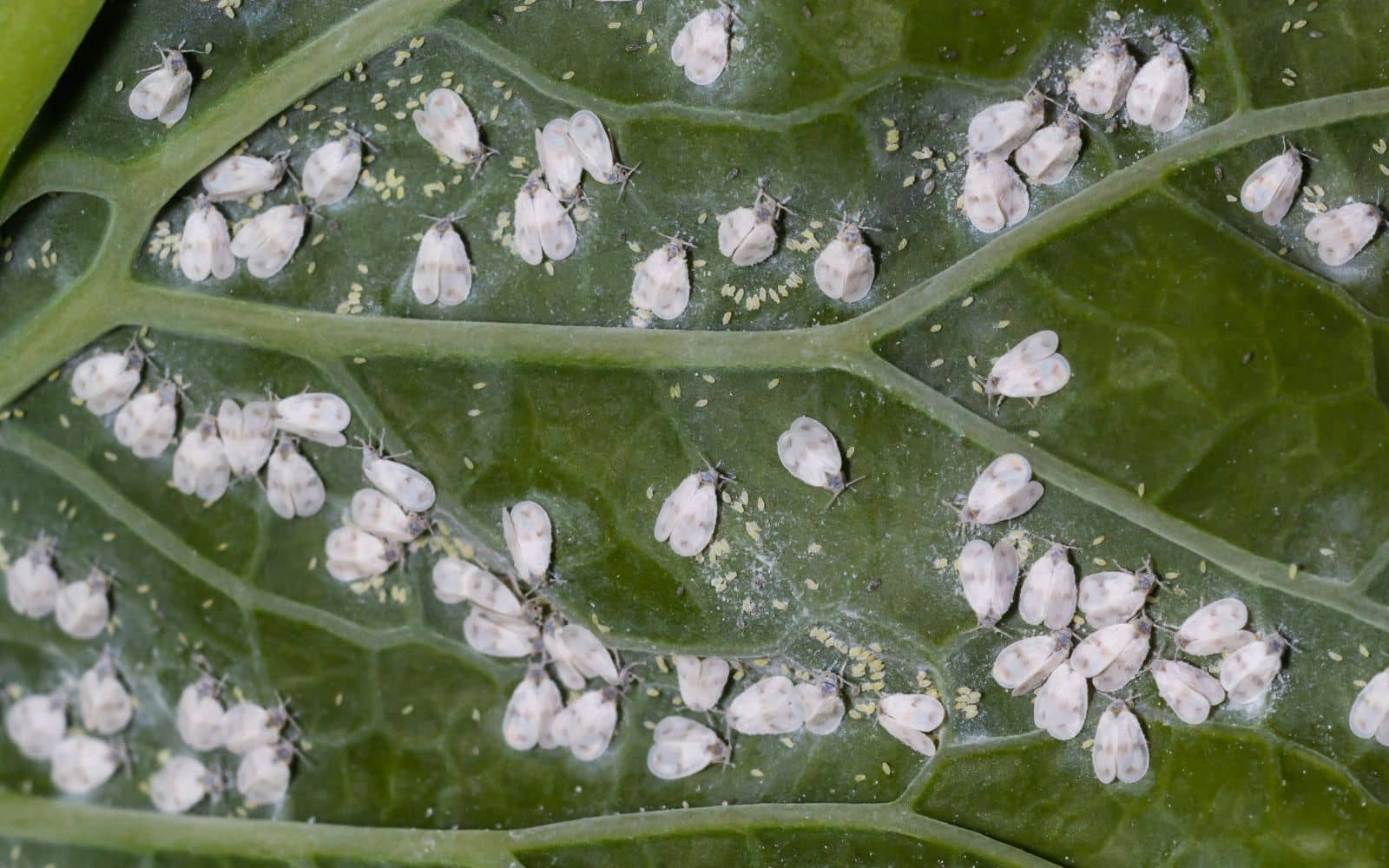
Whiteflies are small sap-feeding insects that grow up to 2 mm long. These are white and have two pairs of wings folded over the back of the abdomen. Smaller whiteflies crawl over plants but soon settle at the foliage to feed and become immobile scales.
| Species | Characteristics |
|---|---|
| Trialeurodes vaporariorum | Insects, eggs, and scales present on the underside and upper leaf surfaces |
| Aleyrodes proletella | Affects cabbage and other brassica crops. Found during a colder winter month |
| Dialeurodes Chittenden | Infects young leaves of rhododendrons that are detected in June and July |
| Pealius azaleae | Pale green, fast scale infests undersides of leaves and sticky honeydew and mold at the plant’s upper surface |
| Aleurotrachelus jelinekii | The appearance of sooty molds on the upper surface of leaves with black and white wax frill on surface |
Vegetable plants such as tomatoes and cucumbers are often get attacked by this insect. If you are growing other plants such as begonias, chrysanthemums, cinerarias, and hibiscus in the greenhouse, pay particular attention to this insect.
It also attacks outdoor plants and weeds in summer that, with a persistent infestation, reduce plant health, and sooty molds make diseased plants look unsightly. The leaves of the plant develop yellow spots and other discolorations.
How to treat:
Prevention is the key to controlling the damage. You should examine your plants regularly for any sign of infestation.
If you see any adult or baby whiteflies, spray it thoroughly with an appropriate contact or systemic insecticide. Depending on the infestation’s severity, you can repeat spray on two or three occasions at about weekly intervals.
If infestation is not severe, you can hang a yellow sticky trap above the infested plant to catch whiteflies. You can also disturb plant foliage to make whiteflies fly up onto traps.
Another easier way to clean infestation is by using a hand-held battery-operated vacuum cleaner to suck up whiteflies.
4. Capsid Bugs

Capsid bugs are also known as Mirids. These are small but highly active insects that grow up to 6 mm long. Adult capsid bugs have hardened forewings, antennae, and hind wings membranous. Nymphs are similar but without wings.
Capsid bugs have a different color depending on the species, and it can range from pale yellow and green to red-brown. These bugs feed on the plant sap by piercing the plant tissue with fine stylets and injecting saliva into it to feed.
Some species of capsid bug also prey on other insects such as mites, aphids, and caterpillars. Small ragged holes appear in young leaves, followed by characteristic tattering when capsid bugs infect the plant.
It destroys the buds and shoots that causes the deformed fruit or flower. You need to sift through the plant as they quickly fly away when disturbed. Most damage is done in late spring and during the summer, and several different types of garden plants may be affected.
| Species | Characteristics |
|---|---|
| Lygocoris pabulinus | Attacks many wild and cultivated fruits and ornamental plants. Female lays an egg in winter before dying |
| Calocoris norvegicus | Attacks chrysanthemum and other members of Asteraceae plant as well as potatoes |
| Plesiocoris rugicollis | Attacks apple tree branches and shoots. Nymphs feed on leaves and young fruitlet |
| Lygus rugulipennis | Yellow-green with red-brown marking insects. Congregates on Arctotis and Chenopodium bonus-Henricus plants |
How to treat:
The biggest challenge with Capsids is its identification. These are elusive bugs, and control is not always easy. But once you have identified the infestation, you can use a combination of chemical and non-chemical methods.
During winter, rake leaves litter and clear other plant debris that may provide safe harboring ground for capsids eggs. You can also spray with systemic or non-systemic insecticides in May, June, and July when the pests are more active.
If you have planted edible fruits like strawberries, raspberries, then spray it immediately before flowering. For plants like apples, pears, and plums, spray it with insecticide after flowering.
Ornamental plants should be treated in spring and early summer. If you see capsids dropping from plant to ground when disturbed, spray soil surface to eliminate them.
5. Froghoppers
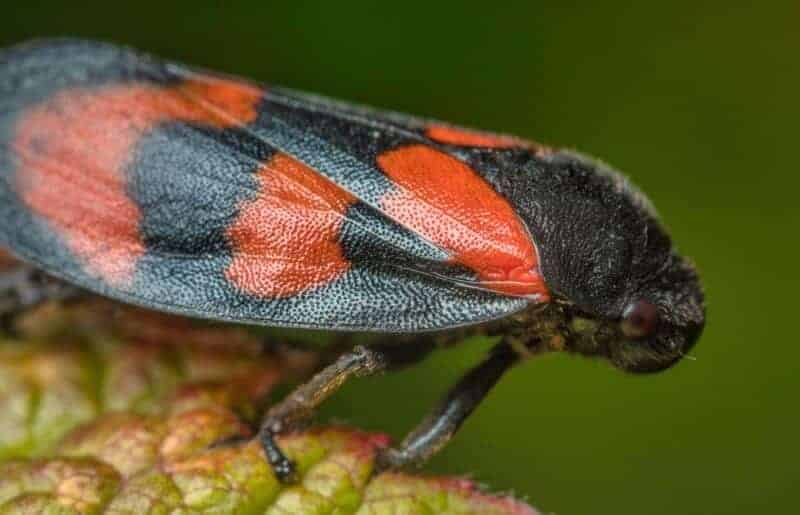
Froghoppers are medium-sized sap-feeding insects. It grows up to 6 mm long and has frog-like prominent eyes and powerful hind legs. Adult froghoppers jump from one plant to another when disturbed.
Pale color nymphs feed on stems, leaves, and plant roots under a covering of foam, known as “cuckoo spit.”
There are two main varieties of Froghoppers:
- Philaenus spumarius
- Cercopis vulnerata
Froghoppers start to appear on plants from May onwards. You may identify the infestation by looking at the plants as young growths get distorted and occasionally wilt.
Both edible and ornamental plants are equally susceptible. You may often find froghoppers feeding on blackberries, raspberries, perennial asters, chrysanthemums, lavender, roses, and phlox.
Female froghopper lay eggs in batches of about 30 in stems of shrubs during autumn. These eggs overwinter and hatch in May. Nymphs start to feed on the plant and protect themselves by forming a foam. These mature by late July and feed till autumn before laying eggs and dying.
How to treat:
You can use jet spray water to remove foam and nymphs from the infested plant. A garden hose or pressurized sprayer should do the trick.
You can wash the plant thoroughly to remove it from the plant physically, so these bugs don’t have a chance to form a colony.
6. Basidiomycete Fungi (Rusts)
Basidiomycete fungi produce small powdery areas of fungal growth on leaves, stems, or other parts of plants. Due to its distinct color left on the plant, it’s also known as rust.
Rusts affect a wide range of fruits, vegetables, trees, and ornamental plants in the garden. These fungi are from the genus Puccini family and have over 4,500 species in the world.
Many species have complex, highly sophisticated life cycles. These fungi may produce up to five different spore types during its development.
| Species | Characteristics |
|---|---|
| Melampsoridium Hiratsukanum (Alder Rust) | Forms masses of pale brown layer underside of leaves which gradually wither and die |
| Puccinia Antirrhini (Antirrhinum Rust) | Chocolate brown pustules with surrounding yellow halo underside leaves and pale yellowish spots on the upper surface plant as well as potatoes |
| Puccinia Recondita (Aquilegia Rust) | Small orange cluster cups underside leaves in summer and fungus on bentgrasses |
| Uromyces Armeriae (Armeria Rust) | Develop with pale brown pustules on purple spots on either or both leaf surface |
| Puccinia Asparagi (Asparagus Rust) | Rust-colored powdery pastures develop on the feathery shoots during summer, followed by dark brown streaking on the stems. |
| Uromyces Appendiculatus (Bean Rust) | Dark brown pustules on leaves, stems, or pods |
There are five different spores’ types produced by rust fungi during their development.
1. Pycniospores: It’s produced in small flask-shaped structures, usually on the upper surface of leaves. It’s surrounded by sweet secretion that attracts insects and then transfers to a new plant. It’s hard to see with the naked eye.
2. Aeciospores: It’s produced in aecia, which are cup-like in shape and embed into the host plant tissues with an opening to the surface for the spores to escape. You can easily see them and identify them as rust infection symptoms.
3. Urediniospores: Most typical type of rust is often called summer spores and is typically light-colored. Some may appear dark brown and spread disease rapidly in summer.
4. Teliospores: These are black or dark color fungi produced later in the season. These usually need a period of dormancy before germination and can survive the winter.
5. Basidiospores: It’s produced from germinating teliospores and brings infection to the host plant.
It’s claimed that excessive fertilization with high nitrogen content aggravates the effect of rust on the plant. You need an effective fungicide to control rust.
How to treat:
Fungicides made of copper and sulfur compound has been widely used to treat it. There are also modern systemic chemicals available against rust but may only be used on ornamental plants.
Wherever it’s possible, the diseased plant should be destroyed and should not be left on the ground unless necessary. Spraying fungicide every two or three weeks from early July to late September provides adequate protection.
7. Mealybugs
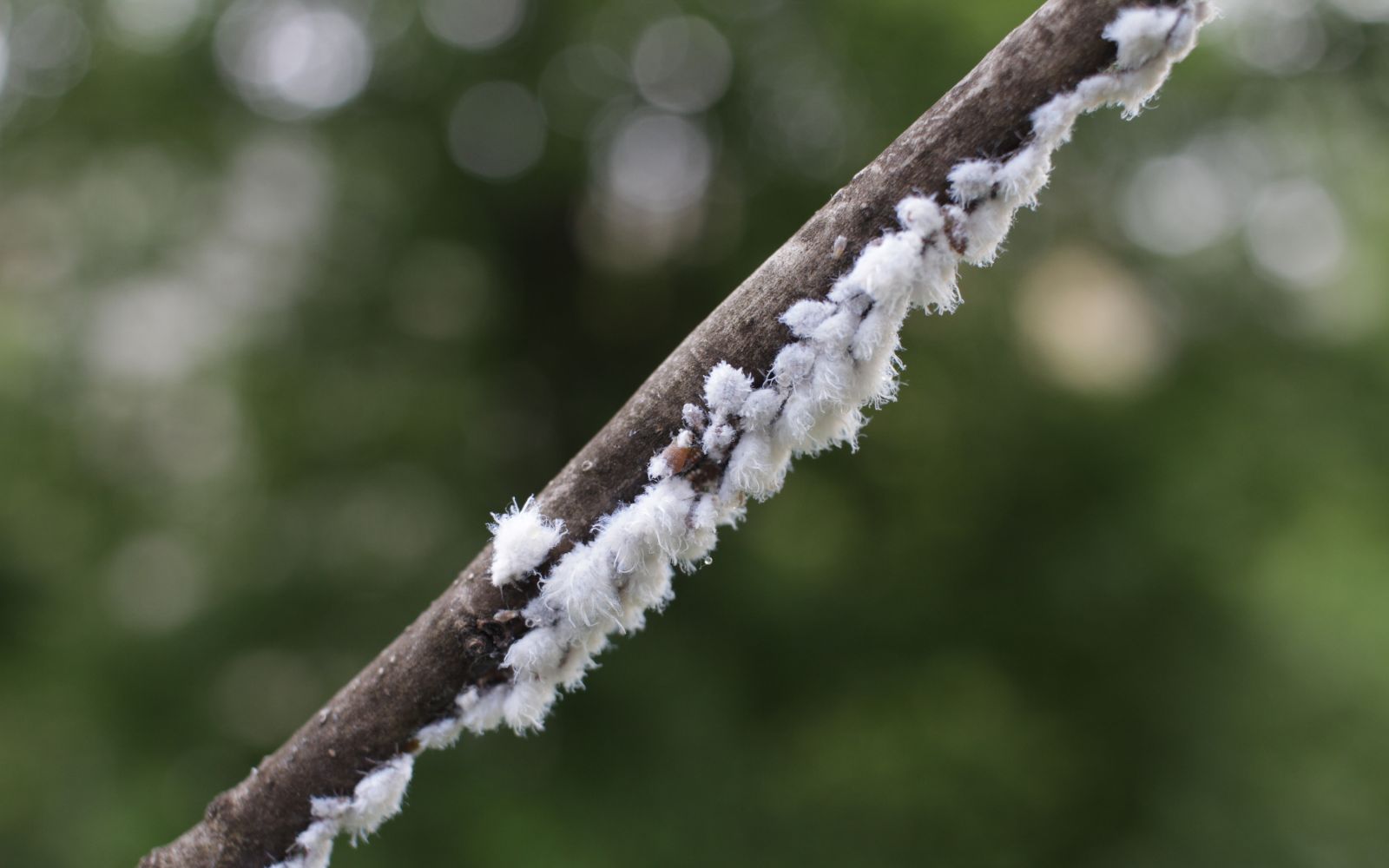
Mealybugs are small sap-feeding insects that grow up to 4 mm long. These are some of the most common damaging insects found in the garden. The male mealybugs have wings, whereas females are wingless.
Mealybugs have soft, elongated oval bodies covered by white wax powder and wax filaments. There are many different types of species in the wild and particularly troubling for home and greenhouse plants.
The three most common types of mealybugs are:
- Pseudococcus Viburni: These are also known as glasshouse mealybugs. These bugs will primarily infest glasshouse plants in the colder temperature and affect outdoor warmer season plants.
- Root mealybugs: These are similar to glasshouse mealybugs, but they mainly feed on plant roots. Don’t be confused about root mealybugs with root aphids or springtails. These do the most damage when plants are growing in dry potting compost or dry borders.
- Trionymus Diminutus: These are also known as Phormium Mealybug. It grows up to 4 mm long and infests leaves of flax. It releases a white waxy secretion that accumulates in the leaf and affects the plant’s overall health.
The persistent infestation with mealybugs weakens the plants. The damage is more severe when growing parts of plants are colonized and covered on the surface with honeydew and sooty molds.
Plants such as vines, potatoes, anthuriums, begonias, cacti, codiaeums, ferns, hoyas, jasmines, and several others are equally susceptible to mealybugs damage.
These bugs grow very fast as each female mealybug lays a batched egg of 100-150. These eggs are covered in a protective woolly wax coating.
As the temperature rises, the eggs hatch in a few days and start feeding on the plant. Nymphs are immobile for an extended period when feeding but can move on to a fresh plant after a while.
How to treat:
Treating mealybugs are not easy as they live in hard-to-reach places in the plant. The wax covering on the top protects them from insecticides.
To treat mealybugs, you must first remove as many colonies as possible by cutting infected shoots and branches and subsequently burning it.
You can clean the mealybugs from the plant surface by spraying it with water or using a paintbrush. You can dip the brush in a spray-strength solution of insecticide for a more desired effect.
After you have physically removed the most mealybugs from the plant, you can treat it with systemic or non-systemic insecticide.
Prevention is the key, and you should avoid introducing mealybugs into a clean collection of plants. You can examine new plants more closely and keep it separate if you suspect any sign of infestation.
Treat it aggressively if you see infestation and repeat the treatment two or three times at about fortnight intervals.
8. Wasps
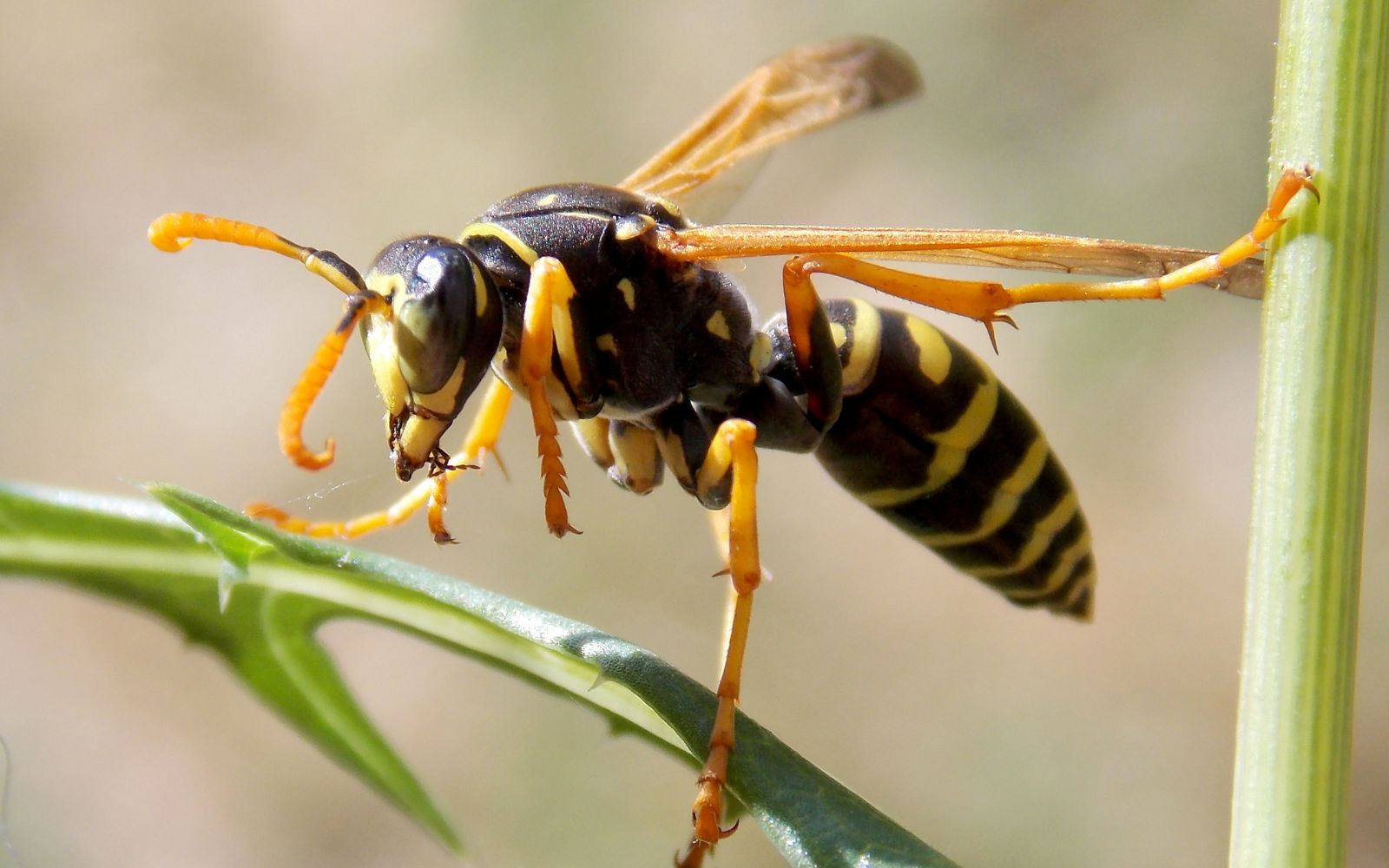
Wasps have very distinct characteristics that make it easy to identify them. It grows up to 20 mm long and has bright yellow and black markings on its back.
There are over eight different wasps species, and it has larger varieties, also known as a hornet.
Wasps are most visible during summer and early autumn. They feed on ripening fruits such as apples, pears, plums, and grapes. They also damage ornamental plants such as dahlias by scraping the stems to remove tissues to build nests.
There are two common species of wasp:
- Paravespula vulgaris
- Paravespula germanica
These wasps usually construct nests in cavities in soil, walls, and buildings. But some varieties make nests among twigs and branches of shrubs and trees. The nest is made from chewing small wood pieces and mixing it with wasp saliva.
Queen wasp takes shelter under loose bark on trees or garden sheds during winter. Queen wasp feed larvae made of caterpillars and other insects. As the worker wasp grow up, they take over the nest building and feed in early June.
How to treat:
Wasp grows fast when the weather condition is favorable to them. If you can identify a wasp net growing in your garden, you should remove it immediately.
The best time to do is during nighttime when the worker wasp is inside the nest. Wasp visiting your garden can be trapped using baiting jam jars or other containers filled with honey.
You can add detergent and water with honey that traps and drown wasp. You can discourage wasps by preventing bird damage to fruits as it reduces the open area in fruit that wasps find attractive.
If you get stung by a wasp, you can treat the area using mild antiseptic and cold compress antihistamine cream.
9. Mites
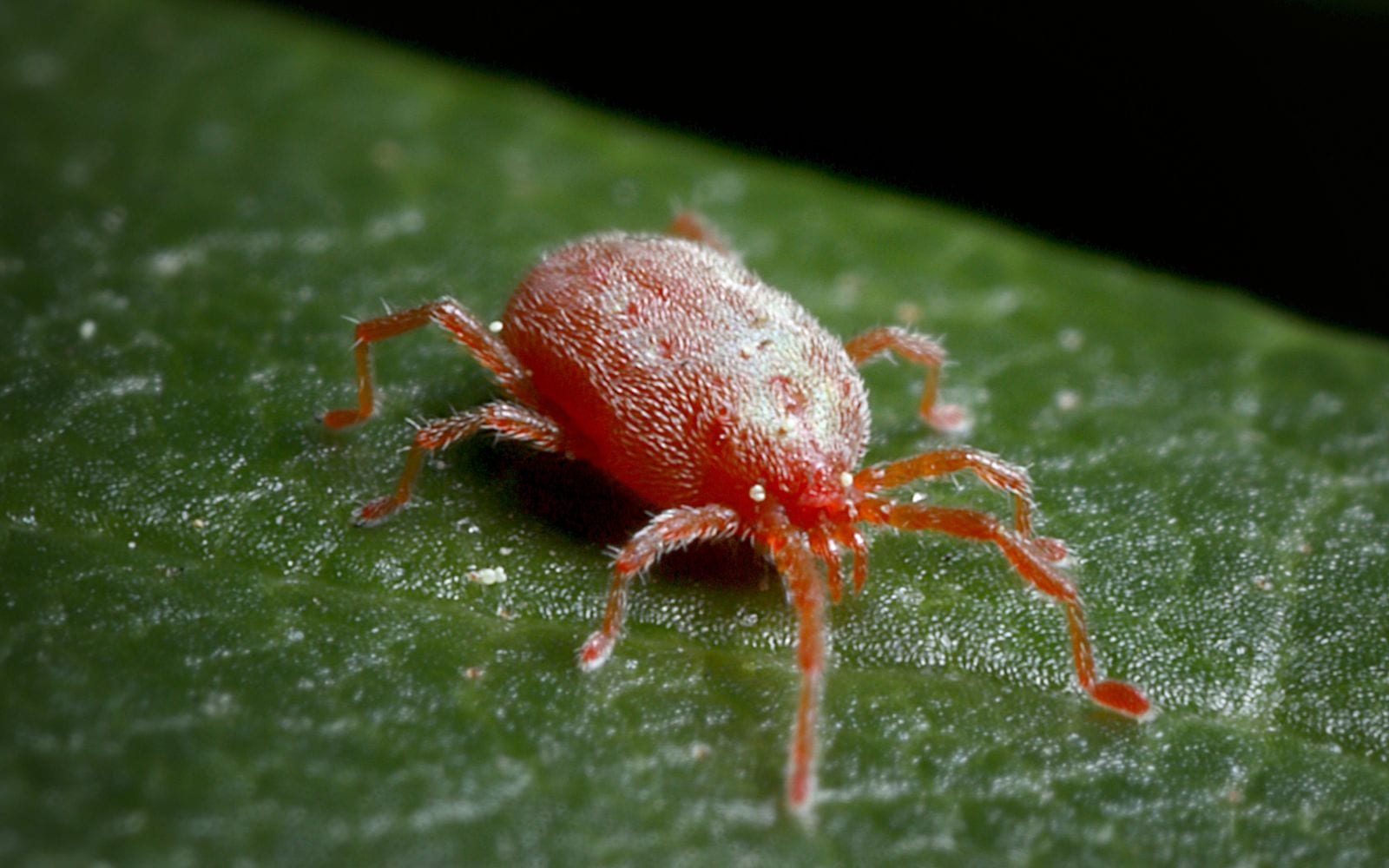
Mites are usually considered to be an indoor nuisance, but these are also garden decimators. These are tiny insects usually 1-2 mm long and are found in large clusters.
There are several species of mites that are scavengers, feeding in soil, or decaying organic matters. But some feed on healthy plant tissues. These become gardening pests and should be controlled promptly.
Mites are fast breeders when conditions are favorable, and they are often less susceptible to other insecticides. There are different types of mites, but the following are the most common varieties:
Red spider mites:
These are tiny mites usually 1 mm long, but they are fast movers. It develops colonies on leaves and other parts of plants. They feed on the sap and cell content of plant tissues that resulting in withering or discoloration to plants.
Carmine spider mite:
These mites are often found in glasshouses and indoors. The infestation is visible by localized pale-yellow spots on the upper surface of leaves. A careful examination of the affected areas reveals multiple minute spherical eggs. The damage to plants increases with the increase in the mite population.
Common spider mite:
It attacks fruit trees such as apples, plums, peaches, nectarines, and strawberries. It builds up the colony on leaves from April onward, and the plant’s damage becomes apparent in June or July.
Conifer spinning mite:
These are specialized mites who built colonies on conifers during summer. It affects foliage of the plant that turns yellow and severe damage causes premature fall of trees. These mites also attack other plants such as spruces, cedars, cypresses, and thujas.
Lime mite:
These develop colonies on the undersides of leaves in summer. Many mites swarm over the lime tree trunk in fall and cover it with silk webbing.
Bryobia mite:
This variety of mites attacks fruit and ornamental plants. It shows the same kind of symptoms, as shown by a red spider mite.
Usually, mites feed on plant leaves in spring and summer. It causes progressive discoloration around the leaves and affects the health of the plant. When you find them in your garden, the control measure should start immediately.
How to treat:
Few chemicals are specially formulated to control the mite population. General insecticides may become effective initially, but soon mites become resistant to the leading group of insecticides.
The other effective method to control the mite population is through biological means. It involves introducing a predatory species of mite that feeds on other mites.
For example, for red spider mite, the Phytoseiulus persimilis is a predatory mite. These are slightly larger than red spider mites with long legs and move fast.
An adult predatory mite can kill about 5 to 6 grown adult mites or around 20-25 immature mites a day. Female predator mites lay their egg among red spider mite colonies. The newly hatched predator mites feed on red spider mites.
Some localized mites such as Byrobia have a minimal infestation and don’t need any special treatment. You can simply wash them off from plants using a high-pressure wash to keep them away.
10. Beetles
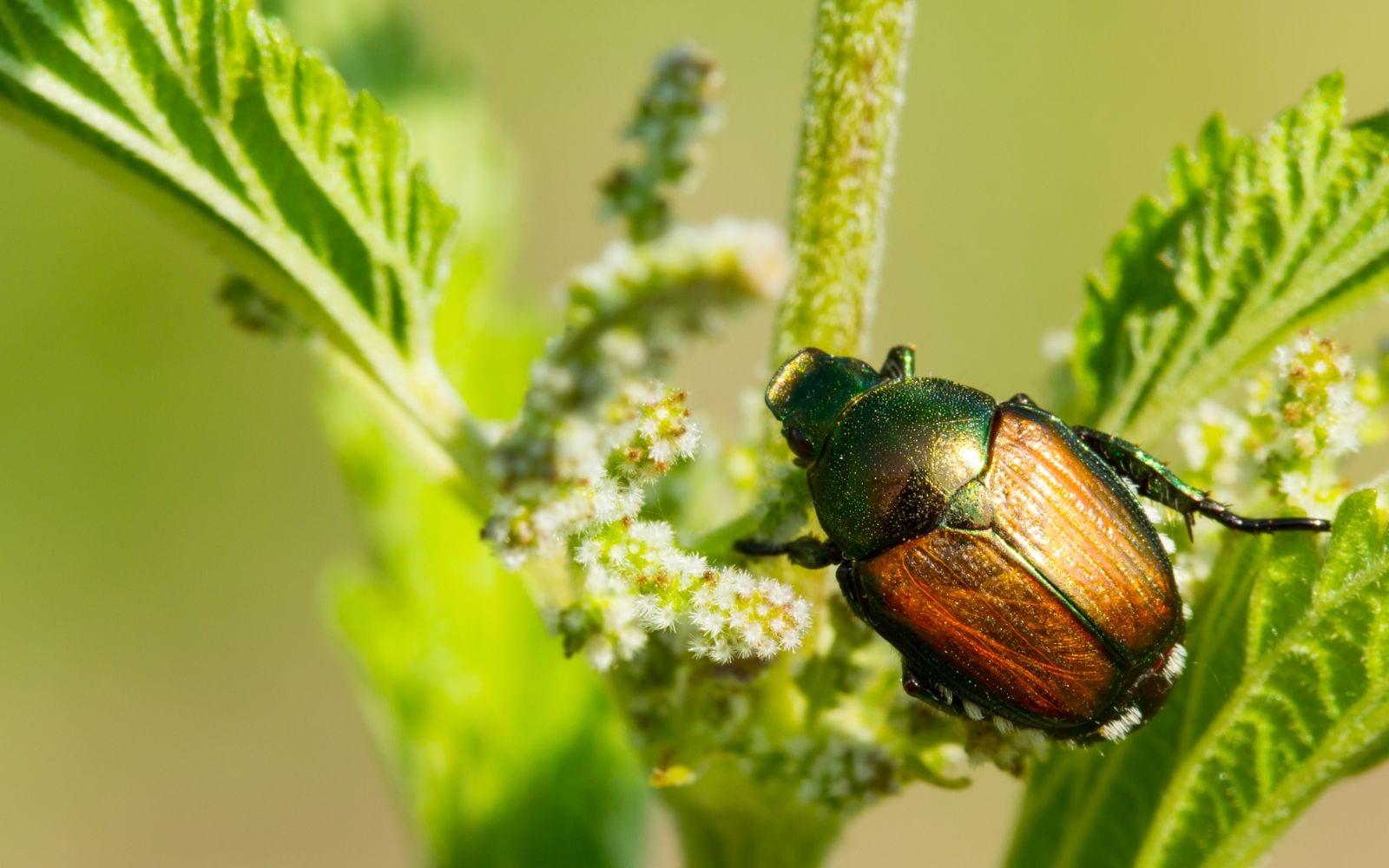
There are more than 400,000 known species of beetles. They are found in most of the world. They have species that range from small 1 mm to 3 cm long. Most are black, grey, or brown, but some are also in a bright color.
The female beetle lays eggs on or near food and deposit it individually or in clusters. The beetle larvae have a well-developed head with soft bodies.
Predator beetle feeds on other insects and could be beneficial to the garden. At the same time, different varieties feed on dead wood and living plant tissues.
Bettles such as chafers, wireworms, nut weevils, and pollen beetles affect fruits, vegetables, and ornamental plants. They often feed on roots, corms, tubers, and stems of garden plants.
Plant attacked by beetle wilt and die quickly. When your garden gets attacked by beetles, brown, withered areas appear during dry weather conditions.
Female beetle lay eggs in the soil near the plant during early summer, and larvae hatch a few weeks later. These newly hatched larvae feed underground on roots, corns, and deadwood until they are ready to pupate.
Wireworms beetle can flick themselves into the air when lying on their back. These are usually found in grasslands but sometimes also attack gardens.
The other type, Byturus tomentosus, has yellow-brown larvae that grow up to 8 mm long and has a brown head and brown dorsal marking.
It feeds in and on ripening fruits of raspberries, blackberries, and blueberries. They do substantial damage to the plant by feeding on buds and flowers earlier in the season.
How to treat:
If you got an infested lawn with beetles, then a heavy rolling in late spring kills pupae and emerging adult beetles.
You can also do proper watering and feeding to encourage the growth of the grasses. Beetles must not have a favorable ground condition for development.
Any leftover unattended compost heaps or heaps of stacked tuffs attract wireworms’ beetles. For edible plants such as strawberries, raspberries, and blueberries, you can clear the bed in autumn by removing old straw and other plant debris.
In early spring, reduce the beetle population by trapping them in a jar buried at the ground level and opening. In a severe infestation, chemical control may be needed to check the beetle population exposure.
Larvae must be killed before they have a chance to start damaging fruits. When it’s necessary, you can spray the plant with natural pyrethrum or a synthetic pyrethroid insecticide.
You can do it on raspberries and loganberries after flowering has finished and the first fruit ripen. If there is still a sign of beetle presence, make the second application two weeks later.
Note:
Aim to reduce the risks of killing pollinating insects by applying insecticides in the late evening.
11. Scale Insects
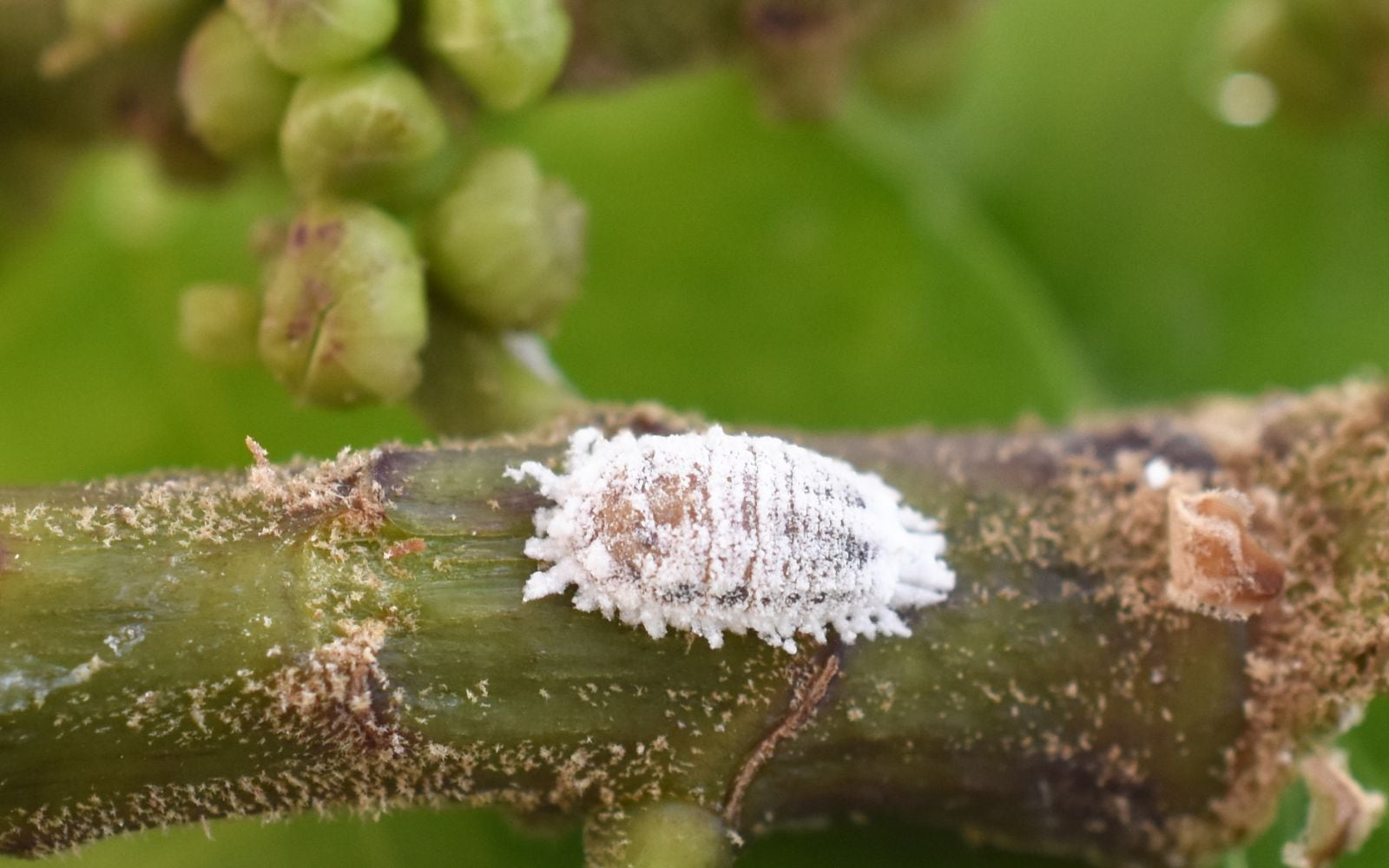
Scale insects are small sap-feeding insects. These have white, yellow, or brown wax scales up to 5 mm long covering their body. These remains are static on plants and feed by piercing into plant tissues and moving on to fresh plants later.
Scale insects target leaves, stems, and fruits. Like aphids, these excrete honeydew, which makes plants sticky and encourages the growth of sooty molds. The extent of scale damage to a plant depends on the size of its colony.
A persistent infestation of scale insects weakens plant growth and makes it unsightly. Ornamental plants are the main target of attacks for scale insects.
The most widespread and troublesome scale insects are noted below:
Coccus Hesperidum:
These are soft scale insects with elongated, flat shape that grows up to 4 mm long. It has varied colors and shapes with an outer scale that has a light brown and dark center. It attacks ornamental plants such as clematis, ferns, hibiscus, oleanders, and many others.
Saissetia coffeae:
These are hemispherical scales with dark brown color when mature. It has an H-shaped ridge, and host plants heavily influence the size and shape. These are most often found in greenhouses, especially at a higher temperature. It attacks flowers such as carnations, codiaeums, ferns, and orchids.
Parthenolecanium corni:
This is also known as the brown or peach scale as it primarily attacks peaches and nectarines. It grows up to 5 mm long, and peaches, plums, grapevines are the main fruits affected by this pest.
Aspidiotus nerii:
These are tiny size scale insects that look like miniature fried eggs. It forms colonies undersides of leaves of home plants such as acacias, ericas, laurels, and palms. Interestingly, it does not produce honeydew.
Pulvinaria regalis:
These are also known as horse chestnut scales and form dense colonies on branches and trunks. Infestation is most common in summer when females mature.
Lepidosaphes ulmi:
Also known as mussel scale, these are blackish-brown scales that grow up to 3 mm long. These form dense crusting colonies on woody stems and branches of ornamental flower and fruit trees.
Those are a few of the most common types of scales. Other types affect cultivated plants, and their symptoms and treatments are usually the same.
How to treat it:
Fortunately, scale insects are easy to treat as these are very much immobile pests. They only move a couple of centimeters and are either blown away by winds or stick to flying birds.
Most gardens get scale insects when they bring a new plant that is already infected by scale. You should adequately check new plants for any type of infestation before you place it with other plants.
You can usually treat these with chemicals when the crawlers are young and before they get settled on plants.
A thorough application of non-persistent contact quickly kills scales, but you have to apply it in late spring and early spring to be most effective. If you are late to destroy newly laid eggs, you can use systemic insecticides to kill maturing females.
You can use a biological control method for a light infestation, such as introducing parasitic wasp ‘Metaphycus helvolus’ in your garden.
12. Eelworms
Eelworms are also known as nematodes and are microscopic pest that is 1-2 mm long. It’s hard to see them with the naked eye unless you are inspecting them under dark background.
Eelworms can be found in soil, water, and plant tissues. These are parasitic and feed on plant tissues internally or externally. These have sharp teeth that puncture plant cells and extract fluid contents.
The damaged plant gets distorted, discolored, and in extreme cases, dies. Female eelworms lay eggs either in the plant itself or in soil. They grow very fast in favorable conditions. It gets transported when an infected plant, debris, or dirt is moved.
Eelworms affect both edible and ornamental plants. When it infects the seed or bulb, it makes it crack and rot. It’s hard to notice eelworms visually, and symptoms may be confused by the presence of other pests and diseases.
Infested plant seeds and bulbs feel soft and show discolored brown rings of dead tissues when cut. After the plant has decayed, the eelworm leaves and moves to a fresh plant.
How to treat:
Prevention is vital to stop the plants get infected by eelworm. Following good gardening hygiene and crop rotation is a good start. You should buy good-quality bulbs from reputable vendors to ensure no other bulbs get infected by eelworms.
If you find infestation developed, despite all the precautions, further spread by removing affected plants and seeds. You can either destroy it by deep burying in the ground or burning the plant.
When you are planting new bulbs, you can do hot water treatment. In this, you immerse dormant narcissus bulbs in hot water (112 F) for three-four hours.
Ensure the temperature is high enough to kill the worm but don’t damage the delicate plant tissues inside.
13. Sooty molds
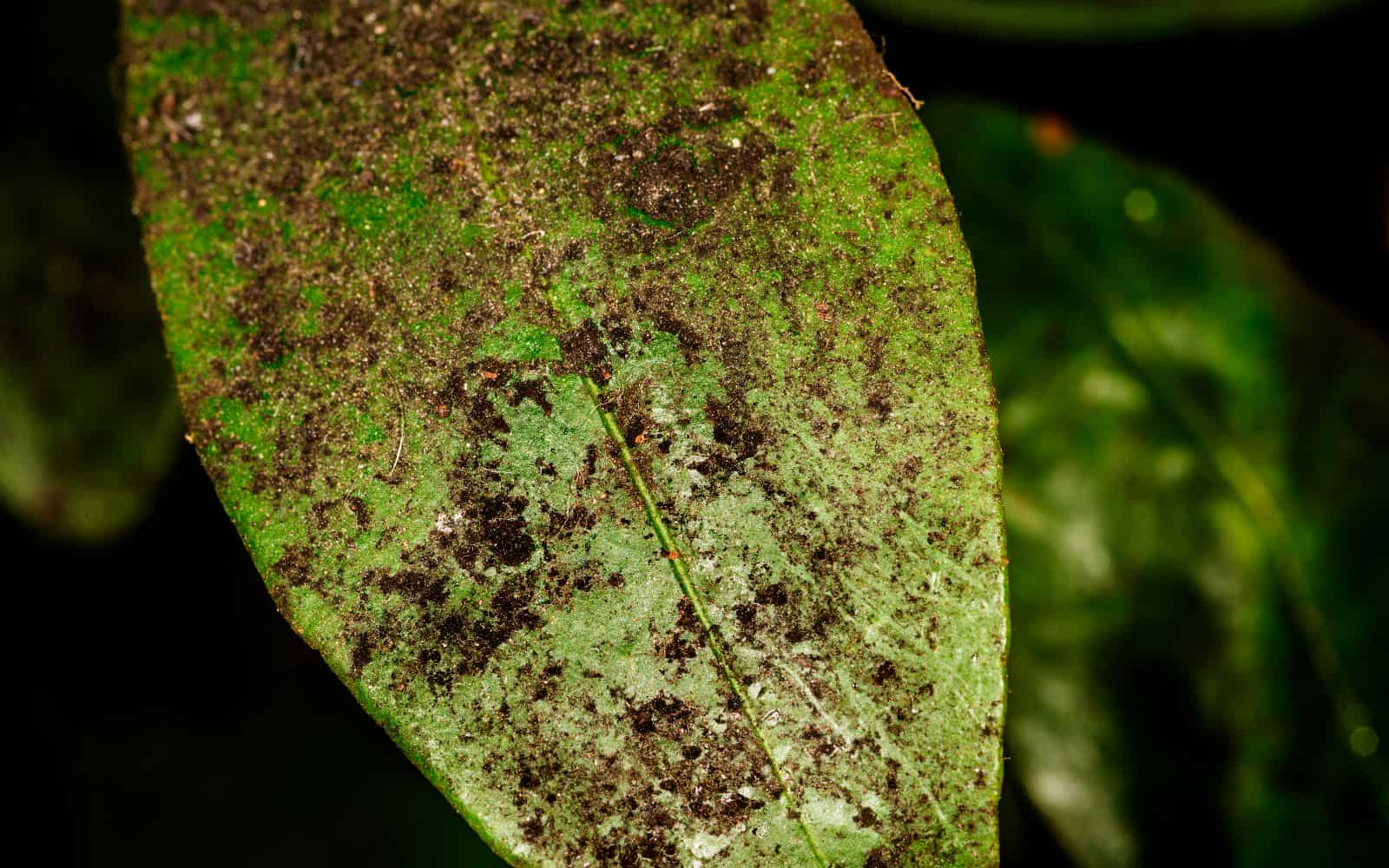
These are black or dark brown soot-like deposits that appear on the upper surface of leaves or other parts of the plant.
These are usually generated by sap-feeding pests such as aphids, adelgids, whiteflies, or scale insects.
The main reason for developing sooty molds is the excretion of sugar honeydew fluids derived from the sap on which pests feed. These small droplets of honeydew accumulate on leaves, stems, and fruits of the plant that further attract other insects.
Several non-pathogenic fungi grow on the contaminated plant surface and produce sooty deposits of fungal spores and mycelium. These molds overgrow and cover the surface of affected leaves and plants.
Interestingly, these sooty molds don’t directly harm the plant, but the residual black deposit stops sunlight from reaching the leaves and disrupts the photosynthesis process. It causes the leaves to wilt and fall off, which weakens the plants.
How to treat it:
The best remedy for sooty mold is to wash it off from leaves and plants. You can spray it with plain water to remove thick deposits from leaves.
If you see contamination on fruits, you can clean it by washing or wiping it. Fortunately, molds don’t penetrate beneath the fruit skin, so it’s safe to eat.
14. Millipedes
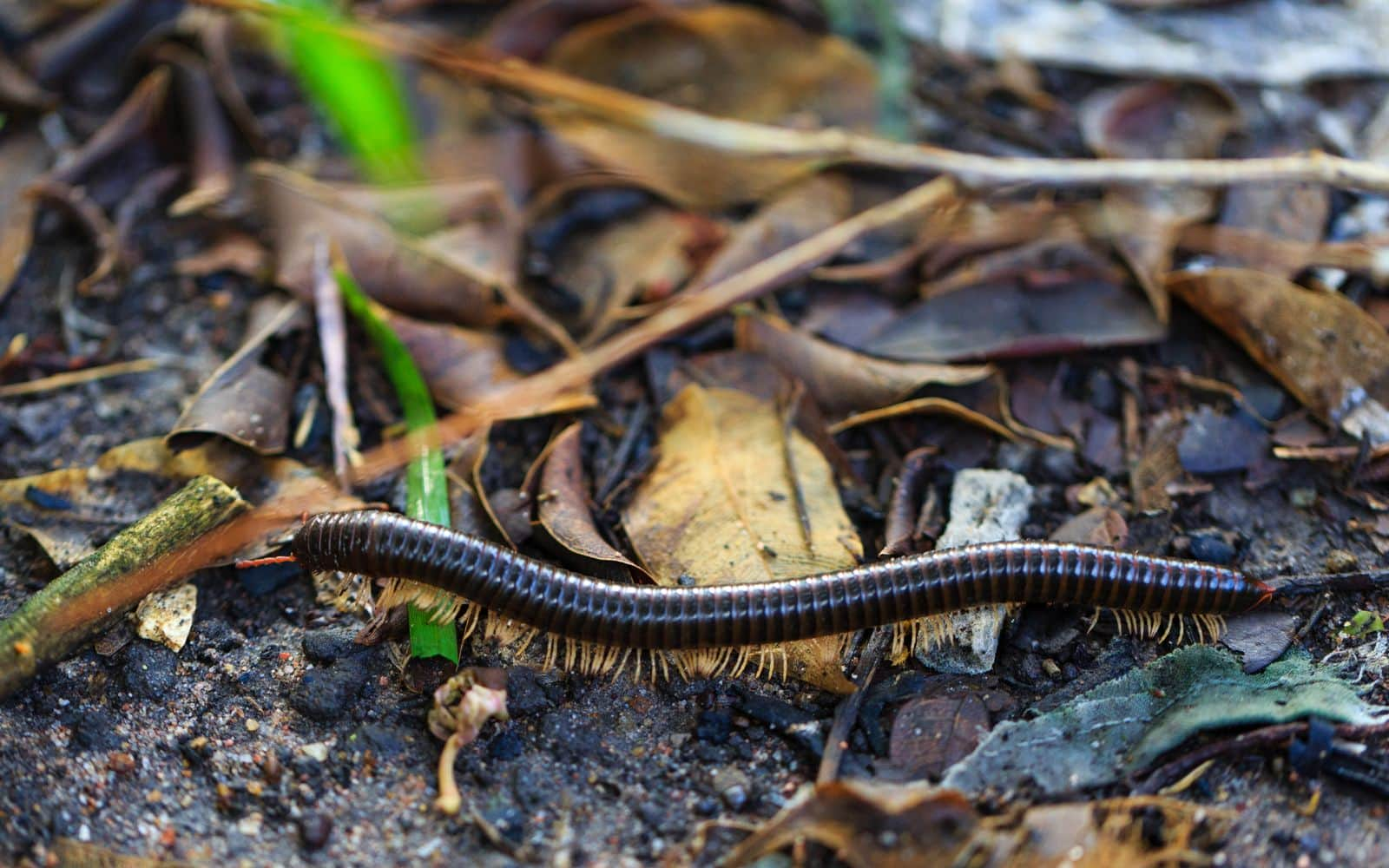
Millipedes are segmented arthropods that are made of 50 articulated segments and two pairs of legs per segment. People often get confused millipedes with centipedes. The main difference is centipedes have only one pair of legs per segment that allows it to move quickly.
Millipedes primarily feed on dead plants, but they also feed on seeds, bulbs, roots, corms, and plants’ tuners. Often these damages invite other insects such as slugs or pathogens.
The most common plants affected by millipedes are strawberries, carrots, cucumbers, potatoes, daffodils, and tulips. Spring and summer is the time when it breeds. Female millipedes lay 50-100 eggs in a small soil chamber.
Nymphs hatch in 2-3 weeks and are smaller with fewer body segments. As they grow, the number of segments increases. Millipedes can live for 2-3 years and remain inactive in the soil in winter.
How to treat:
Millipedes grow fast in soil that is high in organic matter. Decaying plants, debris, and rubbish is a common breeding ground. Good garden hygiene is essential to reduce their population.
Pay attention when bringing new plants into your garden. Check it thoroughly and ensure there is no millipedes colony around. You can protect susceptible seeds, bulbs, and corms by working insecticidal dust into the soil.
You can also trap these insects and physically remove them. You can use insecticides in an extreme infestation but use it sparingly, so it doesn’t kill beneficial pollinators in the garden.
15. Wilts

Wilts are caused by Deuteromycete fungi that produce wilt-causing agents and destroy the plant.
It’s a prevalent disease caused by soil or seed-borne organism. Wilt disease symptoms are often difficult to distinguish from root and foot rot or other stress factors to plant. It affects plants such as fruits, vegetables, ornamentals, and trees.
Some of the most common garden plants affected by wilts are asters, beans, begonias, carnations cherries, dahlias, raspberries, potatoes, and tomatoes. The list is quite long, and most vegetables and ornamental plants are susceptible to wilts.
You can identify wilt as the appearance of brown or black discoloration form on the stem.
The discoloration may happen upward or downward toward the roots of the plant. But if it’s confined to the basal parts, it’s more likely to be caused by root damage than by wilt.
The wilt damage happens as a result of the blockage of the water-conducting tissues of the stem. Lack of water starves the leaves of water. The inside plant cells collapse because of gums and other materials, causing a physical obstruction.
The production of a toxic substance by pathogens in the conducting tissues causes wilt effects. Many wilt organisms persist for several years in the soil. It’s also commonly associated with eelworm attacks and wounds caused by pests.
How to treat it:
It’s sometimes difficult to identify and treat wilts. The best thing you can do is to plant wilt-resistant plants. Sometimes wilt-resistant rootstocks are used to which wilt-prone cultivators are grafted.
If you’re planting in a greenhouse, increase the shading in glasshouses and apply no basal water but spray it above the foliage. Keep an eye on any diseased plant and remove the infected.
It’s also wise to remove the contaminated soil and let the place dry for a few days before you fill it up with fresh, uncontaminated soil.
16. Scabs
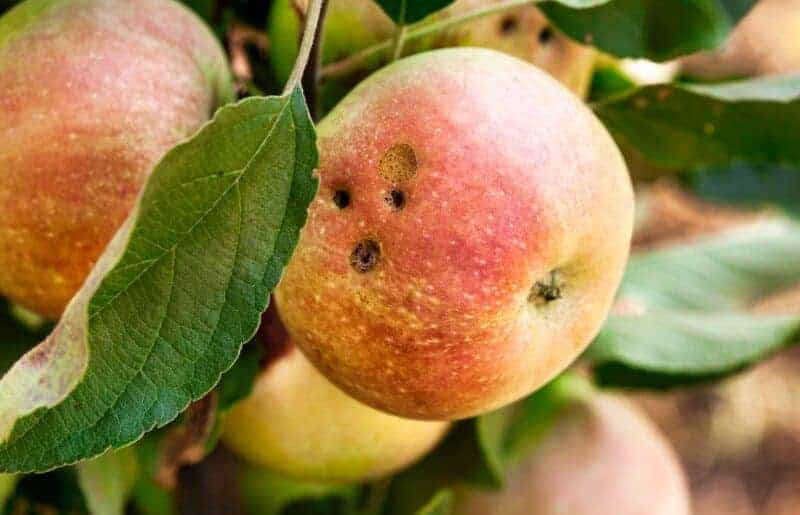
Scabs affect fruits, vegetable roots, and potato plants. These are characterized by swollen, rough, corky lesions on fruits and vegetables.
Apple scabs are the most common example and a huge problem for commercial producers where fruit’s distorted appearance lowers the product’s value.
Soil-borne scabs are caused by bacteria or protozoans and are challenging to treat. Species of the fungus Venturia cause fruit scabs.
Here is a list of the most common scabs that affects edible plants:
Venturia inaequalis :
This is the most common and widespread scab that affects apples. It generates powdery mildew that causes blemishes to the fruit.
In fruit, at first dark spots appear that later become greenish or corky. On the leaves, it generates round greenish-blotch, the center of which becomes blackened and then grey.
Venturia cerasi:
This scab affects cherries. It appears as small, dark green on fruit. The affected cherry grows unripened and may drop prematurely.
Streptomyces scabies:
It creates scabby spots with a distinct appearance on the plant, sometimes covering the tuber. The lesions may be superficial or form a deep pitting.
It produces similar damage to powdery scabs that is more prevalent on heavier and wetter soils.
Venturia pyrina:
It’s similar to apple scab and caused by almost the same related fungus. It targets pear plants where the leaf and fruit get speckled with dark brown colors, and the fruit gets distorted.
Venturia carpophila:
Affects plums, peaches, and nectarines, causing rounded green-brown spots on the fruit, which may crack and fade. Similar color spots also appear on the leaves and twigs of plants.
Spongospora subterranea:
It’s prevalent in the wet season or heavy soils that affect root vegetables. Sometimes, it develops as a canker type of malformation that can often be mistaken for other disease types.
As there are different types of scabs, the treatment varies depending on the severity of infestation. For example, for apple scab, several treatment options are possible.
You can use commercial fungicide spray for scab control in a commercial orchard. It reduces the need for more expensive treatment for fruit.
How to treat:
You should continue the spray until the blossom drop or no further infection is present. Wood scab is also an indication of neglected trees, and you can cut it out.
For prevention from common scab, you can use cultivars that are resistant to scab. You can apply green organic matters such as lawn mowings to light soil with humus deficiency.
On light, sandy land, scab occurrence can be lessened by watering potatoes just when tubers are beginning to form.
17. Symphylids
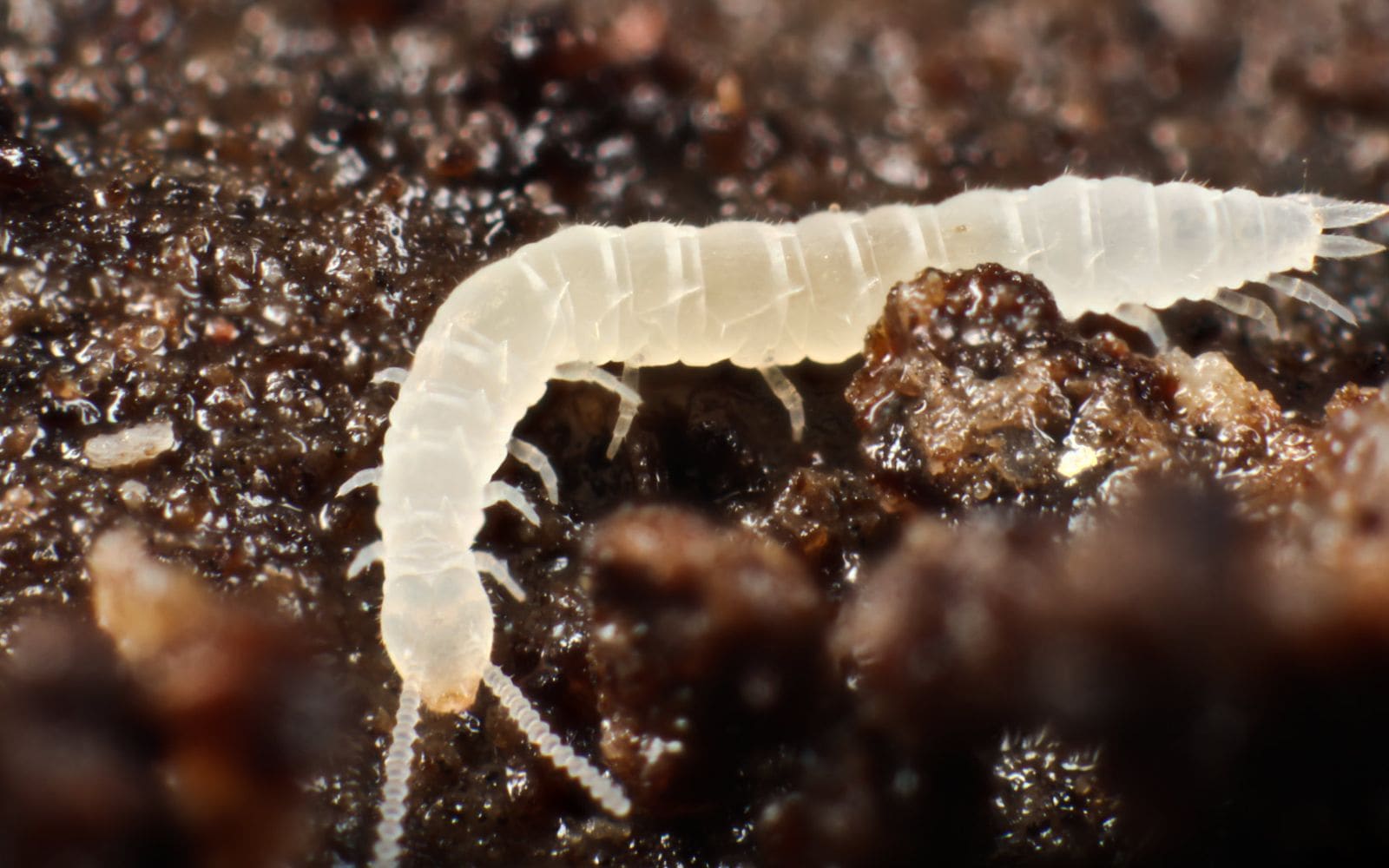
Symphyla is small arthropods that grow up to 1 cm long. It has a long white body with 12 pairs of legs and antennae. It’s related to centipede and millipedes that make people often get confused.
It lives in soil and eats root hairs and fine rootlets. After it has infected the plant, it can also tunnel into larger roots.
A plant with a damaged root causes it to wilt and die. A symptom of symphylids attack is the occurrence of blue or red tinges on foliage.
A weakened root also causes the plant to deal with a secondary invasion by bacteria and fungi. Both edible and ornamental plants are susceptible to attack. Tomatoes, lettuces, and chrysanthemums are more prone to get attacked.
Vegetables such as asparagus, beans, celery, cucumber, peas, and anemones are other favorite targets. You can examine the soil to determine the presence of symphylids.
If possible, you can lift a whole plant and place the roots into a bucket of water. If present, symphylids will float to the surface.
Larvae and adults feed near the soil surface in late winter and early spring. As the temperature rises in summer, their population explodes. When the upper soil layer dries out in summer, symphylids migrate deeps downwards underground.
How to treat:
It’s hard to treat symphylids with insecticides alone. Usually, by the time you notice an infestation, it causes irreparable damage to plant roots.
You should remove the damaged plant from the garden and fill it with water to wash it away.
Also, check the soil and new plants before planting them in the garden. Proper care and paying attention to overall plant health may help you identify infestation early so you can take preventive measures.
18. Sawflies

Sawflies are tiny, usually less than 10 mm long, flying insects. It has two pairs of wings with dark bodies and legs. It looks like flying ants and female sawflies have saw-like ovipositors that she uses to insert eggs in cuts made in soft plant tissue.
Adult sawflies feed on pollen, but larvae eat leaves and other plant parts. Hoplocampa testudinea, also known as apple sawfly, is white cream larvae that tunnel into apple fruits in early summer.
Many of the fruitlets damaged by sawfly larvae cause the fruit to fall in June-July prematurely. Sawflies larvae overwinter in soil and hatch in spring.
Incidentally, their peak activity coincides with the apple flowering period in April/May. Female sawflies lay about 30 eggs each in the open flower, and a fortnight later, it hatches.
Young larvae cause the most damage as it tunnels into the fruitlets and decimate the developing seeds. They then pick the next healthy fruit and keep on feeding.
Each larva feeds on at least 2-3 fruits. Larvae then drop to the soil in June/July and spin cocoons in which they overwinter.
How to treat:
Once you identify sawflies and its larvae on the plant, take immediate steps to control it. You should spray trees thoroughly with an effective insecticide about a week after the petals have fallen.
Time is of the essence here as these young larvae must be killed before they tunnel into the fruitlets.
During June, you should collect and destroy damaged fruitlets that fell from the tree to reduce the number of larvae completing their development.
19. Earwigs

Earwigs have a long body up to 25 mm long with a body ending in forceps. It has a sizeable hind wing that folds tightly into short wings case.
Forficula auricularia is the most common species of earwig that is damaging to your garden. It harms indoor and outdoor plants.
Earwigs target primarily ornamental flowers such as clematis, dahlias, zinnias, and pansies. It does the damage during the flower blooming period from June to September.
These are nocturnal as it hides inside the damaged flower and feed at nighttime. It decimates the soft buds and leaves growing in the plants.
You can also find earwigs hiding in cavities of fruits such as apples and peaches. They use these spots to hide from predators but don’t cause much damage to the fruit itself.
Female earwig lays 50-100 eggs in the soil and overwinters under stones, wood, and other debris. It lays eggs in December and January, and these eggs soon hatch in a month or two. Female earwig stays with small earwigs and feeds them till they mature during summer.
Earwigs have wings, but it’s not used to flying. They are crawling insects and usually roam around a short distance. Earwigs you see in your garden are generally local breeding from the previous winter and spring seasons.
Earwigs feed on other smaller insects such as aphids. So, it may be destroying your garden, but it also helps control other pest populations.
How to treat:
Good garden hygiene is essential to stop earwigs colonize your garden. Remove any unwanted woods and debris and tidy up the accumulation of the garden waster.
Properly maintain your garden to reduce the place for earwigs to hide. You can also lay down traps around tree trunks or planks using a container filled with vegetable oil.
In a severe case of infestation, treat the area and breeding site with a contact insecticide. You can spray it late in the evening or after dark as this time earwigs are most active.
If you bring container plants indoors, carefully inspect it so there is no earwig or egg present in the container.
As earwigs tend to stay localized, look around the area where you spotted earwigs and check if you can find other colonies. Remove the upper layer of soil to expose eggs and destroy them.
20. Slugs and Snails

Slugs and snails are a common occurrence in the garden. Slugs are soft-bodied insects with a slimy body and moving on large, slimy, muscular feet. On the other hand, snails have a hard shell into which it retracts its body for rest or to hide.
Below is the leading pest species found in the garden:
Deroceras reticulatum (Field slug):
These are light grey and approximately 3-4 cm long. These feed mainly above the ground but also burrow deep in the soil. These are the most common and damaging to the garden. The breeding season is in April/May and September/October.
Arion hortensis (Garden slug):
These slugs can grow up to 4 cm long and have dark grey to black color. It breeds in summer and feeds above and below ground.
Arion ater (Black slug):
These slugs are up to 15 cm long and orange-brown. Even though it’s larger than other slug varieties, these do less damage to the garden than smaller types.
Cornu aspersum (Garden snail):
These have a grey-brown shell up to 3 cm across. You can find them near a drystone wall or around a plantation.
Cepaea nemoralis (Banded snails):
These snails have attractive white, yellow, grey band alternating on a shell. They are quite shy and like to hide in the dark. These don’t do much damage to the garden.
Snails and slugs feed on rasping plant tissues. They have a toothed tongue, which they use to munch on roots, bulbs, corns, stems, and leaves.
When these moves, a characteristic slime trail persist on plants and soil. They are mainly active at nighttime when there is less risk of predators.
These insects increase their activities during the warm and humid temperatures of spring and autumn. These insects target fruits, vegetables, and ornamental plants.
If you are building a vegetable garden, they target pea and bean seeds and destroy it under the soil. You have to be careful when sowing seeds that these slugs don’t destroy it while germinating.
Ornamental plants such as coreopsis, daffodils, dahlias, hostas, and tulips are particularly susceptible to snail and slug attacks.
These cause the most damage in early spring when the plant shoots new crowns and slugs feeding in the soil on bulbs, corms, and tubers. You may also find leaves and stems of plants to be damaged or deformed while growing.
How to treat:
You may often find slugs in soil containing decaying organic matters such as composts and manures. Snails are usually found on calcareous soils and remain inactive in the winter.
Slugs and snails prefer soil with high organic content. Organic content in the soil is good for the plant, and by cultivating it frequently, you can expose the eggs hidden in the ground. Predators such as birds and other insects then remove these eggs from the soil.
Good garden hygiene, such as keeping your garden neat and tidy and restricting the use of mulches around the plant, can also reduce the hiding spots for these insects. You can also trap these by leaving lettuce or cabbage leaves in the garden to attract and remove it.
There are also slug pellets available that you can place in strategic positions in your garden. These pellets remain effective for 3-4 days, and you can repeat the application as needed.
If you are going to use insecticide, it’s best to treat soil areas before planting celery or potatoes to reduce the local slug population. You can also protect ornamental plants’ seedlings by growing it in a seed tray and then transplanting it.
Other means, such as barriers, copper tapes, moisture-absorbent material, and gel repellents, effectively control the slug and snail population.
This Guide is Now Complete, But your gardening journey has just begun
Well, here you are.. at the end of this gardening guide.
Congratulations on making it this fast and understanding how to get started with gardening successfully.
Here at GearTrench, we’ are all rooting for your success and want you to remember that whenever a question comes up about gardening and home decoration…
…our blog, Facebook, and Youtube Channel are always here to help you.
We know that creating a blooming garden is hard work – but done right – it can be rewarding.
Hopefully, this gardening guide will help you become the owner of a thriving garden and a beautiful home.
Thanks for reading, and best of luck from all of us here at GearTrench!

